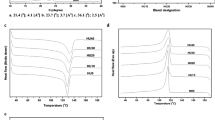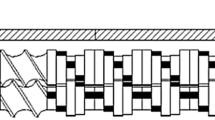Abstract
The mechanical, rheological, and thermal properties of various binary and ternary blends based on polyamide 6 (PA-6), high-density polyethylene (HDPE), and poly vinyl alcohol (EVOH) with variable morphology were comprehensively studied to give a perspective on interfacial adhesion situation. In this regard, transitions in the phase morphology of ternary systems were traced by means of scanning electron microscopic investigations, varying the type of matrix and composition in the minority phase. Theoretical and experimental analyses of impact and tensile properties provided support for the compatibilizing action of EVOH on HDPE/PA-6 immiscible blends. Rheological and thermal studies were also performed to make a broader image on the interphase region in ternary systems with core-shell and individually-dispersed minor domains. The most interesting finding was that there is a tendency for PA-6 to partially encapsulate HDPE domains within the EVOH continuous phase. This is roughly supported by SEM micrographs, but yield stress measurements placed too much emphasis on the morphological status.












Similar content being viewed by others
References
Deng S, Zhao X, Huang Y, Han X, Liu H, Hu Y (2011) Deformation and fracture of polystyrene/polypropylene blends: a simulation study. Polymer 52:5681–5694
Busche BJ, Tonelli AE, Balik CM (2010) Morphology of polystyrene/poly(dimethyl siloxane) blends compatibilized with star polymers containing a γ–cyclodextrin core and polystyrene arms. Polymer 51:1465–1471
Bhadane PA, Tsou AH, Cheng J, Ellul M, Favis BD (2011) Morphology and continuity development in highly reactive nanoscale polymer blends. Polymer 52:5107–5117
Ravati S, Favis BD (2010) Low percolation threshold conductive device derived from a five-component polymer blend. Polymer 51:3669–3684
Ravati S, Favis BD (2011) 3D porous polymeric conductive material prepared using LbL deposition. Polymer 52:718–731
Ravati S, Favis BD (2010) Morphological states for a ternary polymer blend demonstrating complete wetting. Polymer 51:4547–4561
Virgilio N, Sarazin P, Favis BD (2011) Ultraporous poly(l-lactide) scaffolds prepared with quaternary immiscible polymer blends modified by copolymer brushes at the interface. Polymer 52:1483–1489
Virgilio N, Sarazin P, Favis BD (2010) Towards ultraporous poly(l-lactide) scaffolds from quaternary immiscible polymer blends. Biomaterials 31:5719–5728
Bhattacharyya AR, Ghosh AK, Misra A, Eichhorn KJ (2005) Reactively compatibilised polyamide6/ethylene-co-vinyl acetate blends: mechanical properties and morphology. Polymer 46:1661–1674
Zhong G, Wang K, Zhang L, Li Z-M, Fong H, Zhu L (2011) Nanodroplet formation and exclusive homogenously nucleated crystallization in confined electrospun immiscible polymer blend fibers of polystyrene and poly(ethylene oxide). Polymer 52:5397–5402
Takahashi S, Okada H, Nobukawa S, Yamaguchi M (2012) Optical properties of polymer blends composed of poly(methyl methacrylate) and ethylene–vinyl acetate copolymer. Eur Polym J 48:974–980
Zhang X, Li B, Wang K, Zhang Q, Fu Q (2009) The effect of interfacial adhesion on the impact strength of immiscible PP/PETG blends compatibilized with triblock copolymers. Polymer 50:4737–4744
Veenstra H, Verkooijen PCJ, van Lent BJJ, van Dam J, de Boer AP, Nijhof APHJ (2000) On the mechanical properties of co-continuous polymer blends: experimental and modelling. Polymer 41:1817–1826
Sivalingam G, Karthik R, Madras G (2004) Blends of poly(ε-caprolactone) and poly(vinyl acetate): mechanical properties and thermal degradation. Polym Degrad Stab 84:345–351
Yordanov C, Minkova L (2005) Fractionated crystallization of compatibilized LDPE/PA6 blends. Eur Polym J 41:527–534
Bose S, Bhattacharyya AR, Kodgire PV, Misra A (2007) Fractionated crystallization in PA6/ABS blends: influence of a reactive compatibilizer and multiwall carbon nanotubes. Polymer 48:356–362
Sung YT, Han MS, Hyun JC, Kim WN, Lee HS (2003) Rheological properties and interfacial tension of polypropylene–poly(styrene-co-acrylonitrile) blend containing compatibilizer. Polymer 44:1681–1687
Horiuchi S, Matchariyakul N, Yase K, Kitano T, Choi HK, Lee YM (1997) Compatibilizing effect of maleic anhydride functionalized SEBS triblock elastomer through a reaction induced phase formation in the blends of polyamide6 and polycarbonate: 2 Mechanical properties. Polymer 38:59–78
Valera TS, Morita AT, Demarquette NR (2006) Study of Morphologies of PMMA/PP/PS Ternary Blends. Macromolecules 39:2663–2675
Horiuchi S, Matchariyakul N, Yase K, Kitano T (1997) Morphology Development through an Interfacial Reaction in Ternary Immiscible Polymer Blends. Macromolecules 30:3664–3670
Saeb MR, Khonakdar HA, Razban M, Jafari SH, Garmabi H, Wagenknecht U (2012) Morphology Prediction in HDPE/PA-6/EVOH Ternary Blends: Defining the Role of Elasticity Ratio. Macromol Chem Phys 213:1791–1802
Shokoohi S, Arefazar A (2009) A review on ternary immiscible polymer blends: morphology and effective parameters. Polym Adv Technol 20:433–447
Reignier J, Favis BD, Heuzey M-C (2003) Factors influencing encapsulation behavior in composite droplet-type polymer blends. Polymer 44:49–59
Virgilio N, Desjardins P, L’Espérance G, Favis BD (2009) In Situ Measure of Interfacial Tensions in Ternary and Quaternary Immiscible Polymer Blends Demonstrating Partial Wetting. Macromolecules 42:7518–7529
Yeh J-T, Huang S-S, Yao W-H, Wang I-J, Chen C-C (2004) Oxygen permeation resistance of polyethylene, polyethylene/ethylene vinyl alcohol copolymer, polyethylene/modified ethylene vinyl alcohol copolymer, and polyethylene/modified polyamide–ethylene vinyl alcohol copolymer bottles. J Appl Polym Sci 92:2528–2537
Yeh J-T, Huang S-S, Chen H-Y (2005) Barrier resistance of polyethylene, polyethylene/modified polyamide, and polyethylene/blends of modified polyamide and ethylene vinyl alcohol bottles against permeation of polar and nonpolar mixed solvents. J Appl Polym Sci 97:1333–1344
Yeh J-T, Chen H-Y, Tsai F-C (2006) Gasoline Permeation Resistance of Polypropylene, Polypropylene/Ethylene Vinyl Alcohol, Polypropylene/Modified Polyamide, and Polypropylene/Blends of Modified Polyamide and Ethylene Vinyl Alcohol Containers. J Polym Res 13:451–460
Yeh J-T, Huang S-S, Yao W-H (2002) Gasoline Permeation Resistance of Containers of Polyethylene, Polyethylene/Modified Polyamide and Polyethylene/Blends of Modified Polyamide and Ethylene Vinyl Alcohol. Macromol Mater Eng 287:532–538
Yeh J-T, Chao C-C, Chen C-H (2000) Effects of processing conditions on the barrier properties of polyethylene (PE)/modified polyamide (MPA) and modified polyethylene (MPE)/polyamide (PA) blends. J Appl Polym Sci 76:1997–2008
Samios CK, Kalfoglou NK (1998) Compatibilization of poly(ethylene-co-vinyl alcohol) (EVOH) and EVOH/HDPE blends with ionomers. Structure and properties. Polymer 39:3863–3870
Lagaron JM, Powell AK, Bonner G (2001) Permeation of water, methanol, fuel and alcohol-containing fuels in high-barrier ethylene–vinyl alcohol copolymer. Polym Test 20:569–577
Wang B, Yang Y, Guo W (2012) Effect of EVOH on the morphology, mechanical and barrier properties of PA6/POE-g-MAH/EVOH ternary blends. Mater Des 40:185–189
Steinmann S, Gronski W, Friedrich C (2001) Cocontinuous polymer blends: influence of viscosity and elasticity ratios of the constituent polymers on phase inversion. Polymer 42:6619–6629
Saeb MR, Khonakdar HA, Jafari SH, Jalalifar N, Razban M, Wagenknecht U (2013) Interface evaluation in the ternary blends of HDPE/PA-6/EVOH. Polymer Bulletin. doi:10.1007/s00289-013-1082-1
Luzinov I, Pagnoulle C, Jérôme R (2000) Ternary polymer blend with core–shell dispersed phases: effect of the core-forming polymer on phase morphology and mechanical properties. Polymer 41:7099–7109
Luzinov I, Xi K, Pagnoulle C, Huynh-Ba G, Jérôme R (1999) Composition effect on the core–shell morphology and mechanical properties of ternary polystyrene/styrene–butadiene rubber/polyethylene blends. Polymer 40:2511–2520
Liu ZH, Maréchal P, Jérôme R (1998) Blends of poly(vinylidene fluoride) with polyamide 6: interfacial adhesion, morphology and mechanical properties. Polymer 39:1779–1785
Choudhury A, Balmurulikrishnan A, Sarkhel G (2008) Polyamide 66/EPR-g-MA blends: mechanical modeling and kinetic analysis of thermal degradation. Polym Adv Technol 19:1226–1235
Shan G-F, Yang W, Tang X-G, Yang M-B, Xie B-H, Fu Q, Mai Y-W (2010) Multiple melting behaviour of annealed crystalline polymers. Polym Test 29:273–280
Wilkinson AN, Clemens ML, Harding VM (2004) The effects of SEBS-g-maleic anhydride reaction on the morphology and properties of polypropylene/PA6/SEBS ternary blends. Polymer 45:5239–5249
Li R, Zhang X, Zhao Y, Hu X, Zhao X, Wang D (2009) New polypropylene blends toughened by polypropylene/poly(ethylene-co-propylene) in-reactor alloy: compositional and morphological influence on mechanical properties. Polymer 50:5124–5133
L-p L, Yin B, Zhou Y, Gong L, M-b Y, B-h X, Chen C (2012) Characterization of PA6/EPDM-g-MA/HDPE ternary blends: the role of core-shell structure. Polymer 53:3043–3051
Author information
Authors and Affiliations
Corresponding author
Rights and permissions
About this article
Cite this article
Rastin, H., Jafari, S.H., Saeb, M.R. et al. Mechanical, rheological, and thermal behavior assessments in HDPE/PA-6/EVOH ternary blends with variable morphology. J Polym Res 21, 352 (2014). https://doi.org/10.1007/s10965-013-0352-9
Received:
Accepted:
Published:
DOI: https://doi.org/10.1007/s10965-013-0352-9




